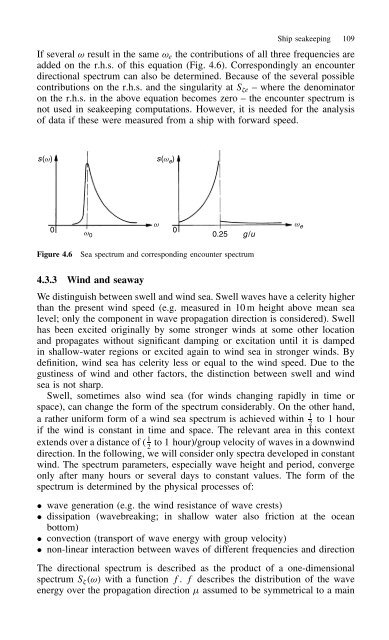Practical Ship Hydrodynamics
Practical Ship Hydrodynamics
Practical Ship Hydrodynamics
Create successful ePaper yourself
Turn your PDF publications into a flip-book with our unique Google optimized e-Paper software.
<strong>Ship</strong> seakeeping 109<br />
If several ω result in the same ωe the contributions of all three frequencies are<br />
added on the r.h.s. of this equation (Fig. 4.6). Correspondingly an encounter<br />
directional spectrum can also be determined. Because of the several possible<br />
contributions on the r.h.s. and the singularity at S e – where the denominator<br />
on the r.h.s. in the above equation becomes zero – the encounter spectrum is<br />
not used in seakeeping computations. However, it is needed for the analysis<br />
of data if these were measured from a ship with forward speed.<br />
s(w) s(w e )<br />
w we 0 w 0<br />
0<br />
0.25 g /u<br />
Figure 4.6 Sea spectrum and corresponding encounter spectrum<br />
4.3.3 Wind and seaway<br />
We distinguish between swell and wind sea. Swell waves have a celerity higher<br />
than the present wind speed (e.g. measured in 10 m height above mean sea<br />
level; only the component in wave propagation direction is considered). Swell<br />
has been excited originally by some stronger winds at some other location<br />
and propagates without significant damping or excitation until it is damped<br />
in shallow-water regions or excited again to wind sea in stronger winds. By<br />
definition, wind sea has celerity less or equal to the wind speed. Due to the<br />
gustiness of wind and other factors, the distinction between swell and wind<br />
sea is not sharp.<br />
Swell, sometimes also wind sea (for winds changing rapidly in time or<br />
space), can change the form of the spectrum considerably. On the other hand,<br />
a rather uniform form of a wind sea spectrum is achieved within 1<br />
2 to 1 hour<br />
if the wind is constant in time and space. The relevant area in this context<br />
extends over a distance of ( 1<br />
to 1 hour)/group velocity of waves in a downwind<br />
2<br />
direction. In the following, we will consider only spectra developed in constant<br />
wind. The spectrum parameters, especially wave height and period, converge<br />
only after many hours or several days to constant values. The form of the<br />
spectrum is determined by the physical processes of:<br />
ž wave generation (e.g. the wind resistance of wave crests)<br />
ž dissipation (wavebreaking; in shallow water also friction at the ocean<br />
bottom)<br />
ž convection (transport of wave energy with group velocity)<br />
ž non-linear interaction between waves of different frequencies and direction<br />
The directional spectrum is described as the product of a one-dimensional<br />
spectrum S ⊲ω⊳ with a function f. f describes the distribution of the wave<br />
energy over the propagation direction assumed to be symmetrical to a main
















